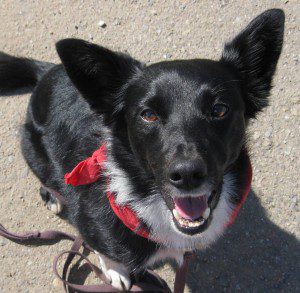Years after we tackled the Relaxation Protocol ourselves (both the one by Dr. Karen Overall and the one our own behaviorist prescribed), it remains one of the top reasons people come to Champion of My Heart. Pretty neat, huh? So, I decided to revisit a couple of the common questions I get about our Relaxation Protocol work.
If you are new to our site, please check out the main Relaxation Protocol page with free audio files and videos.
Relaxation Protocol Questions Answered
We began using the Relaxation Protocol in fall of 2007. Back when I first started, I wasn’t entirely sold on the idea of this detailed, tedious form of behavior modification. Today, all these years later, let me be clear. The Relaxation Protocol provides critical baseline training for fearful (or reactive or aggressive) dogs. I honestly think it sets such an important foundation that I will likely use it with all dogs in my future — whether they are fearful or not.
 Question #1 – Why must the dog sit during the Relaxation Protocol, rather than say lie down and really mellow out?
Question #1 – Why must the dog sit during the Relaxation Protocol, rather than say lie down and really mellow out?
Our behaviorist told me it was VERY important that the dog develops the wherewithal to choose to SIT. It shows a certain confidence and self-control.
It gives them something specific they can do (as a fall-back position). Say, your dog flips out while crossing a road (as Lilly has done), would you rather the default behavior be a SIT or a DOWN?
That’s my way of saying that SIT is much more practical in real life, especially since DOWN can make some dogs feel more vulnerable.
Question #2 – I’ve read that it’s OK to let the dog stay put between the individual Relaxation Protocol tasks. Why do YOU specifically ask Lilly to get up and begin each task anew?
Again, Jennie, our behaviorist, told me that it was important that the dog recognize the end of one task and the beginning of the next.
Indeed, there are times when even after I gave Lilly her release word that she did NOT get up. So, I would actually walk to another part of the room (or wherever) and start the new task fresh by asking for a new SIT/STAY.
I don’t pretend to understand the deep-down brain science behind the repetition (trust me, I know it is skull-bashingly tedious), but by doing these tasks over and over, we’re actually teaching dogs not only how to relax but also creating new neural pathways that help solidify what they learn.
So many fearful dogs do not know how it feels to be calm. They have to learn that. And, by making each task distinct, by making specific requests (SIT and STAY … calm), and by rewarding success with quiet praise and small, soft food rewards … dogs learn to be calmer in the face of all kinds of stimuli.
We hope that they learn that being calmer FEELS BETTER than being upset. And, many fearful dogs need lots and lots of practice.
That’s why you release after each task. That’s why you do the Relaxation Protocol EVERY day for several weeks (or months, in our case).
Relaxation Protocol Revisited
In preparation for this post, I took a little time to run Lilly through Day 1 of the Relaxation Protocol … just to see how she would do.
Lilly was perfect.
Even though we haven’t done the formal Relaxation Protocol in like two years, she recognized the pattern immediately and did everything I asked, which is to SIT/STAY/Be calm, no matter what I did.
Keep in mind that we’ve been using a version of the Relaxation Protocol during “transition times,” when Lilly is likely to be nervous, like when we:
- Go somewhere new
- Arrive at class
- See or hear something out in public that might trigger a fear response
So, it isn’t completely foreign to her, but still. It was fun to go back to our dog training roots and see if she’s still “got it.”
Need other Relaxation Protocol Questions Answered?
People often email me privately, and I’m happy to answer personally, but if there are any other questions about the Relaxation Protocol that you’d like me to address, please let me know by leaving a comment.
Thanks!




I just found this blog and I love it! Thank you for putting this information out there.
When you say release after each task, exactly what does that mean? Do you mean if you do 3 lessons in one day instead of just 1 lesson a day? This is all new to me and I’m trying it with my reactive GSD.
Kim, when I say “release” after each task, I literally mean after each sit-stay. So, for example, … sit/stay for 5 seconds. Release. Sit/Stay for 10 seconds. Release. Sit/Stay while you take 2 steps back and return. Release.
So, give your GSD whatever word you use to let your dog know it’s OK to get up from the sit/stay between each individual ask in that day’s series of tasks. If your dog does not get up, encourage movement by stepping to a new spot in the room before beginning the next task.
You should do one whole series (day 1, day 2, etc.) per day.
I too am new to this concept and will now read back through the previous posts to learn more. It sounds like it might work well for my nervous cattle dog, who’s scared of other dogs.
I just read the protocol for the first time and started thinking that it might be really good for my hyperactive and hyper-vocal dog, R. He’s not fearful or aggressive. Rather, he has a lot of trouble with self-control in exciting situations.
Was the program designed to be used with a dog like R or is it primarily for fearful dogs?
I think it is worth a try to do the RP with R. I believe behaviorists prescribe it for all kinds of dogs, not just fearful ones.